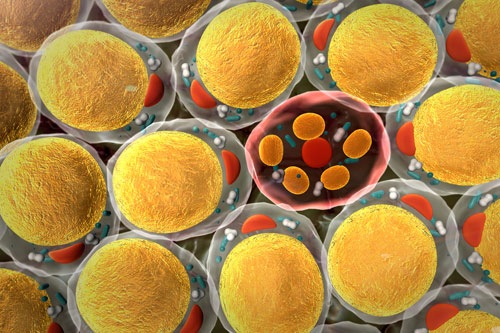Researchers at St. Louis University (SLU) say they have, for the first time, found a way to stop cancercell growth by targeting the Warburg effect, a trait of cancer cell metabolism that scientists have been eager to exploit. Unlike recent advances in personalized medicine that focus on specific genetic mutations associated with different types of cancer, this research targets a broad principle that applies to almost every kind of cancer: its energy source.
The SLU study, which was conducted in animal models and in human tumor cells in the lab, showed that a specific drug can stop cancer cells without causing damage to healthy cells or leading to other severe side effects. Thomas Burris, Ph.D., chair of pharmacology and physiology at SLU and colleagues at the Scripps Research Institute developed the novel therapeutic.
Cancer cells aggressively increase the process of metabolism, allowing mutated cells to grow unchecked at the expense of surrounding tissue. “Targeting cancer metabolism has become a hot area over the past few years, though the idea is not new,” according to Dr. Burris. Since the early 1900s, scientists have known that cancer cells prefer to use glucose as fuel even if they have plenty of other resources available. In fact, this is how doctors use positron emission tomography to scan images to spot tumors. PET scans highlight the glucose that cancer cells have accumulated. This preference for using glucose as fuel is called the Warburg effect, or glycolysis.
In a paper (“Broad Anti-tumor Activity of a Small Molecule that Selectively Targets the Warburg Effect and Lipogenesis”) published in Cancer Cell, Dr. Burris reports that the Warburg effect is the metabolic foundation of oncogenic growth, tumor progression, and metastasis as well as tumor resistance to treatment.
“Cancer cells look for metabolic pathways to find the parts to grow and divide. If they don’t have the parts, they just die,” he said. “The Warburg effect ramps up energy use in the form of glucose to make chemicals required for rapid growth and cancer cells also ramp up another process, lipogenesis, that lets them make their own fats that they need to rapidly grow.”
If the Warburg effect and lipogenesis are key metabolic pathways that drive cancer progression, growth, survival, immune evasion, resistance to treatment, and disease recurrence, then, Dr. Burris hypothesized, targeting glycolysis and lipogenesis could offer a way to stop a broad range of cancers. He and his colleagues created a class of compounds that affect a receptor that regulates fat synthesis.
The new compound, SR9243, which started as an anti-cholesterol drug candidate, turns down fat synthesis so that cells can’t produce their own fat. This also impacts the Warburg pathway, turning cancer cells into more normal cells. SR9243 suppresses abnormal glucose consumption and cuts off cancer cells’ energy supply. When cancer cells don’t get the parts they need to reproduce through glucose or fat, they simply die.
Because the Warburg effect is not a feature of normal cells and because most normal cells can acquire fat from outside, SR9243 only kills cancer cells and remains non-toxic to healthy cells. The drug also has a good safety profile; it is effective without causing weight loss, liver toxicity, or inflammation, pointed out Dr. Burris.
So far, SR9243 has been tested in cultured cancer cells and in human tumor cells grown in animal models. Because the Warburg pathway is a feature of almost every kind of cancer, researchers are testing it on a number of different cancer models.
“It works in a wide range of cancers both in culture and in human tumors developing in animal models,” explained Dr. Burris. “Some are more sensitive to it than others. In several of these pathways, cells had been reprogramed by cancer to support cancer cell growth. This returns the metabolism to that of more normal cells.”
In human tumors grown in animal models, it reportedly worked well on lung, prostate, and colorectal cancers and, to a lesser degree, in ovarian and pancreatic cancers.”
It also seems to work on glioblastoma, an extremely difficult to treat form of brain cancer, though it isn’t able to cross the brain-blood barrier very effectively. The challenge for researchers in this scenario will be to find a way to allow the drug to cross this barrier, the body’s natural protection for the brain, which can make it difficult for drug treatments to reach their target.
When SR9243 is used in combination with existing chemotherapy drugs, it increases their effectiveness, in a mechanism apart from SR9243’s own cancer fighting ability, added Dr. Burris.







